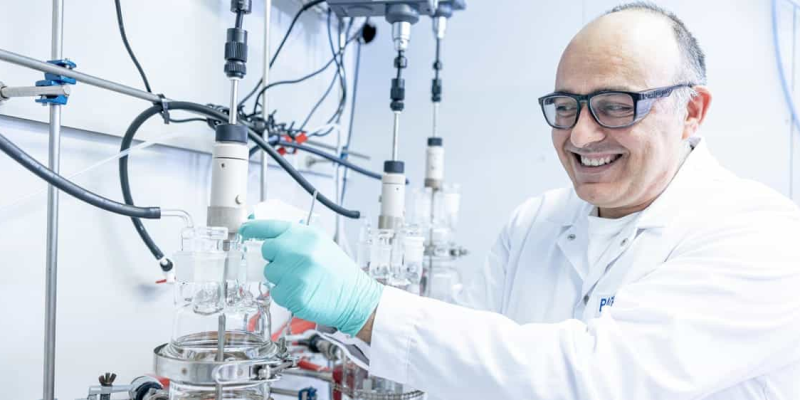Have you ever thought about how your body knows where to heal a wound, how it fights off
harmful bacteria, or how it grows stronger muscles after exercise? All of this is possible thanks to tiny but powerful molecules called peptides.
Peptides play a huge role in how your body functions. They help with healing, immunity, and even muscle growth. Because of their many uses, peptides are very important in science and medicine. Researchers use them to study diseases, create new medicines, and improve treatments.
This beginner-friendly guide will help you understand what peptides are, such as the popular bpc 157 peptide, how they’re made, what they do in the body, and how they are used in medicine and research. We’ll also take a look at how companies like Advanced ChemTech help make peptide synthesis easier and more effective.
What Is a Peptide?
A peptide is a small molecule made up of two or more amino acids joined together in a chain. Amino acids are the building blocks of both peptides and proteins. While proteins are made of long chains (often hundreds of amino acids), peptides are shorter—usually less than 50 amino acids long.
Peptides can be made naturally in the body, but scientists can also create them in labs. Lab-made peptides are often used in research, medicine, and even skincare products.
What Does a Peptide Look Like?
Peptides have a simple but important structure:
- Backbone: This is the main chain of the peptide, made of linked amino acids.
- Side Chains: These are parts of the amino acids that stick out from the backbone and give each peptide its unique properties.
The link between amino acids is called a peptide bond. It forms when the carboxyl group of one amino acid reacts with the amino group of another. This reaction also releases a water molecule.
Peptides can form straight chains, but they can also be shaped into loops or rings, which gives them extra stability. That’s why they are often used in drug development—scientists can design them in special ways to target certain diseases.
Types of Peptides
Peptides come in different lengths and serve many different purposes. Here are the main types:
- Oligopeptides: These are short peptides with fewer than 20 amino acids.
- Polypeptides: Longer peptides with 20 to 50 amino acids.
- Proteins: Made from one or more long polypeptide chains, proteins perform complex tasks in the body like building tissue, sending signals, and speeding up chemical reactions.
Important Roles Peptides Play in the Body
Peptides are involved in many vital body functions. Some of the most important roles include:
1. Cell Signaling
Peptides can act like messengers in your body. They help cells communicate with each other, guiding them on when to grow, divide, or respond to threats.
2. Hormone Control
Many hormones are actually peptides. For example:
- Insulin helps control blood sugar.
- Oxytocin helps with bonding and childbirth.
- Glucagon helps raise blood sugar when it’s too low.
3. Immune Response
Some peptides help fight off infections and diseases by signaling your immune system to act.
Popular Peptides Found in the Human Body
Here are a few well-known peptides and what they do:
- Insulin: Controls how your body uses sugar and stores energy.
- Oxytocin: Supports emotional bonding and helps during childbirth.
- Glucagon: Raises blood sugar by telling your liver to release stored glucose.
Peptides in Medicine and Research
Peptides are becoming more and more important in healthcare. Here’s why doctors and scientists love them:
1. Understanding Diseases
Peptides help scientists learn more about how diseases work by studying how they interact with cells and proteins in the body.
2. Designing Better Drugs
Peptide-based medicines are attractive because they are often safe, effective, and can target specific areas in the body.
3. Medical Uses of Peptides
- Cancer: Special peptides can block the growth of tumors.
- Diabetes: Modified insulin peptides can help better control blood sugar.
- Vaccines and Immune Boosters: Peptides are being used to create more targeted treatments for infections and cancer.
How Peptides Are Made: Peptide Synthesis
Creating peptides in the lab is called peptide synthesis. This is a detailed chemical process that puts amino acids together in a specific order. The three main methods are:
1. Solid-Phase Peptide Synthesis (SPPS)
This is the most common method. The peptide is built one piece at a time on a solid base called a resin. This allows for greater control and accuracy.
2. Solution-Phase Synthesis
This method mixes amino acids in a liquid solution. It’s not used as often, but it can be helpful for certain types of peptides.
3. Stapled Peptides
In this method, scientists add extra components to “lock” the peptide into a certain shape. This helps the peptide stay stable and last longer in the body.
Key Reactions in Peptide Synthesis:
- Coupling: Joins amino acids together.
- Deprotection: Removes chemical groups added to protect parts of the molecule during the process.
- Activation: Prepares amino acids for bonding using chemical helpers.
Natural vs. Special (Unusual) Amino Acids
Most peptides are made from natural amino acids—the 20 kinds found in the human body. But scientists sometimes use unusual amino acids to give peptides new features. These special amino acids can:
- Make peptides more stable
- Help peptides last longer in the body
- Add new functions, like glowing under a microscope (for research)
Some examples of unusual amino acids include:
- Selenocysteine
- Fluorinated amino acids
- Alkyl-modified amino acids
How Advanced ChemTech Supports Peptide Research
Advanced ChemTech offers tools and products that help researchers create complex peptides with ease. Their protected amino acids and high-quality reagents are essential for labs focused on making new medicines, exploring treatments, or understanding how the body works at a molecular level.
The Future of Peptides
Peptides are already helping in major areas of medicine, but their future looks even brighter. Researchers are now working on:
- New cancer treatments using targeted peptides
- Better vaccines and immune therapies
- Safer drugs with fewer side effects
With ongoing research and support from companies like Advanced ChemTech, peptides could transform the way we treat many illnesses in the near future.
Final Thoughts
Peptides may be small, but they have a big impact on health and science. From helping your body heal to fighting diseases and powering cutting-edge research, these tiny molecules are at the center of exciting breakthroughs.
Whether you’re a student, a researcher, or just curious, understanding peptides is a great first step toward learning how science is shaping the future of medicine.
For help with peptide synthesis or to learn more about products for your lab, contact Advanced ChemTech today!







Comments